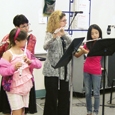Before smart phones, computers, televisions and radio, people found enjoyment in playing games. In the 19th century playing indoor and outdoor games provided not only a source of entertainment, but also created opportunities for social interaction. Parties spent in the company of friends and family might also include impromptu musical concerts and readings from popular novels or the classics.
Some years ago, I developed a set of musical games and activities to enhance education for my flute camps. I have since used these games for studio parties as well as presentations for flute clubs and musical organizations. Games not only offer creative paths to learning, but also give students the opportunity to form friendships.
Create a Timeline
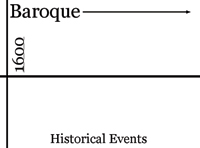 Since games and crafts can make excellent partners, I usually create a Timeline first. This can then be used with other games like Composer Bingo and Name-That-Flute-Tune. Place the timeline on a large bulletin board and have students use colored pushpins to identify the composers and musical style periods.
Since games and crafts can make excellent partners, I usually create a Timeline first. This can then be used with other games like Composer Bingo and Name-That-Flute-Tune. Place the timeline on a large bulletin board and have students use colored pushpins to identify the composers and musical style periods.
This activity helps students understand how musical periods relate to world history. Students should not try to add every possible historical event to the timeline. One student might have a particular interest in political events, while another might include art and literature. The focus should be to relate historical events to composers’ lives and musical style periods. For example, learning that George Washington and Franz Joseph Haydn were born in the same year allows an exploration of the differences and culture contrasts of life in a young country with that of the sophisticated Austrian society. Another interesting thought might be to note that William Shakespeare did not have the music of J.S. Bach to listen to for inspiration, but Bach did have the writings of Shakespeare to read.
My timeline packet includes: pages listing composers for each musical style period (color-coded by period), pages listing historical events (color-coded by musical style period), a roll of paper 12" x 6′ or sheets of paper can be taped together to form the timeline. I also provide students with a marking pen (Sharpie), ruler, tape, glue, and stickers from a scrap-booking store.
Encourage students to be creative. The goal is a well-designed, concise, and informative timeline. Display completed projects in the studio, public library, recital, a local music store, or at a student’s home.
Composer Bingo
Bingo is one of the most popular games. While there are many possibilities to add a musical twist, I construct Bingo games based on composers, general musical knowledge, rhythmic patterns, and musical terms. The games can be played with groups of several students up to 50 or more.
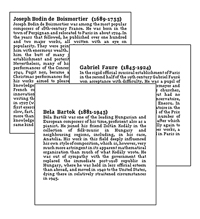 The purpose of Composer Bingo is to help students become familiar with a composer, his life, style period, and compositional output. Each student is given a set of Composer Cards, that they put in order based on dates, and a Bingo card listing five musical style periods where the letters of the word B-I-N-G-O would usually be placed. Underneath the letters are 25 composers’ names. I have made over 50 Bingo cards for each Bingo game. It is easy to create more on a computer; just move and exchange composer’s names to make additional cards.
The purpose of Composer Bingo is to help students become familiar with a composer, his life, style period, and compositional output. Each student is given a set of Composer Cards, that they put in order based on dates, and a Bingo card listing five musical style periods where the letters of the word B-I-N-G-O would usually be placed. Underneath the letters are 25 composers’ names. I have made over 50 Bingo cards for each Bingo game. It is easy to create more on a computer; just move and exchange composer’s names to make additional cards.
The teacher (or another student) has another set up composer cards. The teacher selects one randomly and reads the musical style period, biographical information or a list of compositions, but not the composer’s name. The amount of information given can be adjusted to the reflect the students’ musical knowledge. The players figure out who the composer is and place a marker in the appropriate box on the card. Students are generally allowed to refer to their Composer Cards (there are over 100 in my game set). The rest is classic Bingo.
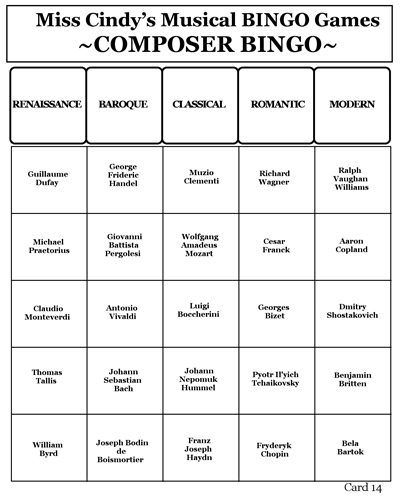
General Music Bingo
This version of Bingo helps students become familiar with terms relating to dynamics, tempo, style/expression, musical forms, and the proper names of musical instruments. This can be a good game to play with less advanced students. As the announcer reads from an information card, he identifies the category and reads the definition of the word. For each word correctly identified, a marker is placed in the appropriate box on the card.
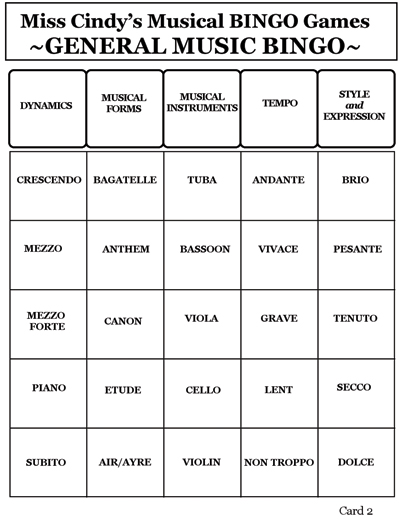
Rhythm Bingo
This Bingo game develops aural skills. The Bingo cards are organized by simple meter (2/4, 3/4, 4/4) and compound meter (6/4, 6/8). Under each of these headings, 25 rhythms are listed. The announcer selects a rhythm which is listed with a suggested metronome speed and taps the rhythm. For each rhythm correctly identified, a marker is placed in the appropriate box on the card. Usually the announcer needs to tap the rhythm several times. Because this is a difficult game for young or rhythmically challenged students, I often pair a younger student with an advanced student.
|
Creating Bingo Game Sets
• I use 150 General Music Cards with the specific category and term name on the front with the definition on the back. The specific categories correspond to those on the Bingo cards. • Each student is given a full set of composer or general music cards. These cards may be laminated for repeated use. For my flute camps, the card sets are part of the packet that each student gets to keep. • Rhythms are recognized through auditory means, so I only have one set of laminated cards with rhythmic patterns and categories for the teacher which correspond to those on the Rhythm Bingo cards. • The teacher has the same sets of cards as the students for each game. The leader picks a card at random (from a basket or bin) and reads the category and definition or biographical information. • I have made over 50 Bingo cards for each game (more can be added, as it is just a matter of moving and exchanging terms to make additional cards). • Each student is given a different Bingo card (all cards are numbered at the bottom) and markers or a pencil to check off completed squares. (Cards may be laminated so they can be reused or printed out if students use pencils or pens to check off a square.) |
Name That Flute Tune
This game helps students develop visual and aural recognition of musical line. It is most appropriate for beginning and intermediate students, but can also be fun for advanced students in a separate setting. Students bring anthology publications they own. Standard examples might be: Forty Little Pieces for Beginning Flute Players; A Treasury of Flute Music; 24 Short Concert Pieces; and Flute Music by French Composers. CD sheet music also works well, and is often a good choice for camp or masterclass settings if prepared packets are provided.
Depending on the nature of the groups (number of students, ability levels) students may play this game in teams or as individuals. If teams are used, one person is designated by the team as the speaker. The teacher states what anthology or collection they will be playing from and then plays a short section of a piece. Hints may be given, such as this is a piece from the Baroque Period. The section does not have to be the beginning of the piece, but certainly may be. When a student recognizes the piece, he raises his hand and is given the opportunity to identify it. If he is incorrect, then the next person who raises his hand is given the opportunity. If no one is able to identify the piece, another section is played; this continues until it is identified.
When this game is played with advanced students, it resembles those old college “drop-the-needle” exams. It is often fun to see if these students can identify pieces having only heard one or two notes.
I often add a twist to this game by having the student who correctly identified the piece place a pushpin above the composer on the group Timeline and then read two historical events that occurred within 30 years of the composer’s life.
Spin-To-Begin, Pick-The-Pro, Away We Go!
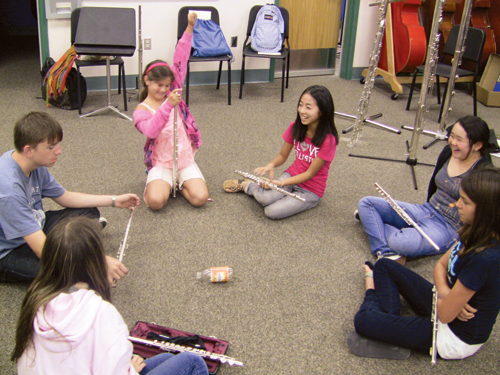
This game is appropriate for every age and playing level. While it can work with one group of flutists, the ideal situation is to have two or more groups: one or two groups of less experienced players (elementary or middle school flutists) and another group of more experienced players (high school flutists or teachers). Spin a bottle with the younger group in a circle. The person the bottle stops on selects a duo, trio, or quartet to be performed. Then spin the bottle to pick a member of the more advanced groups. Continue spinning the bottle until the number of people to play that piece are selected.
Give the group a few minutes to look over the selected music. This is an opportunity for the more advanced flutists to teach and assist the younger students. Then the group performs the music for the rest of the students.
This delightful activity gives students the opportunity to enjoy performing an impromptu concert with people at varying levels of playing ability. In addition, it brings out the best in everyone: advanced students learn through teaching and assisting, beginning and intermediate students gain confidence through playing with others. A wide range of music should be on hand. Participants are also encouraged to bring music for more variety of music.
After the performance, begin the next round so everyone has an opportunity to participate as a player and audience member. Advisory notice: This game is so popular with players of all levels (and ages) that when you schedule it, you might wish to double or triple the length of time you allow.
The study of music often creates a very competitive environment. Games and activities that are fun and purposeful provide a wonderful opportunity to educate and unify. The 20th-century British composer Malcolm Arnold said, “Music is the social act of communication among people, a gesture of friendship, the strongest there is.” If you wish students to enjoy practicing, playing, and performing with others, let them play.
